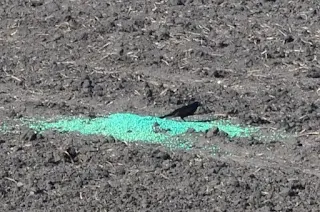By Lizabeth Stahl, Extension Educator in Crops and Bruce Potter, Integrated Pest Management Specialist
A significant amount of seed planted this year will have been treated with one or more fungicide, insecticide, nematicide, or biological seed treatments. The following are some key precautions and reminders to follow when working with treated seed to help prevent pesticide exposure to handlers, non-target organisms, and the environment.
 |
| Treated seed should be cleaned up or covered with soil to prevent exposure to birds and other wildlife. Photo: Liz Stahl |
- Read the seed tag label. This is a basic, but key first step in understanding what steps and precautions to take when working with seed that has been treated with a particular product(s). Be familiar with any restrictions listed on the seed bag label before you use the seed.
- Wear the proper personal protective equipment (PPE) when handling treated seed. Most seed tag labels will state that at minimum, a long-sleeve shirt, long pants, and chemical-resistant gloves be worn when handling treated seed.
- Take care of any spills immediately. Clean up or cover up spills with soil (refer to the seed tag label for specifics) as the seed treatment may be hazardous to birds and other wildlife, or to fish and aquatic invertebrates. Research conducted by the MN DNR, for example, detected residues of neonicotinoids (a commonly-used seed treatment) in the livers of hunter-harvested sharp-tailed grouse and greater prairie-chickens. Spills should also be cleaned up to minimize exposure to people, particularly children.
- Avoid generating insecticide-laden dust when handling treated seed and working with planting equipment. To reduce risk to pollinators, avoid filling or cleaning out planters near flowering vegetation, including woody shrubs and trees. Use appropriate dust-reducing lubricity compounds in the planter instead of talc/graphite, clean and properly maintain planting equipment, watch wind speed and direction, and use technologies to reduce dust drift.
- Be aware of any replant, rotational, grazing, and feeding restrictions. Depending on the product used, there may be limitations on what crop can be planted in a replant situation, or if a cover crop planted in the area could be grazed or used for feed or forage. Refer to the seed tag label for further details.
- Only use a particular seed treatment where you can justify its use. Consider your risk from insect, nematode, and disease pests. In each field, a history of previous problems, weather, cropping system, and genetics influence the probability of an economic yield loss from pests. The potential for yield loss and comparative efficacy of alternative pest management options should be considered when predicting the potential for an economic return when using seed treatments. Utilizing integrated pest management (IPM) can help your bottom line.
- Properly dispose of leftover treated seed. The best and most preferred method is to plant out leftover seed although there may be restrictions on the planting rate and/or depth. Burial may be allowed, but avoid burial next to water sources. Seeding for wildlife habitat is also a possibility when allowed on the seed bag label. Do not compost treated seed, and never burn treated seed in a stove that is used in the home, farm shop, etc.
- DO NOT allow treated seed to enter the food or feed chain. Treated seed is not to be used for food, feed or oil processing, and care must be taken to not contaminate grain going into the food or feed market. There is ZERO tolerance for treated seed in the export market, meaning that a single seed could result in the rejection of an entire load.
This article was first published in April 2019.
Comments
Post a Comment